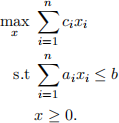ISE 530 Optimization Methods for Analytics Homework 4
Hello, dear friend, you can consult us at any time if you have any questions, add WeChat: daixieit
ISE 530 Optimization Methods for Analytics
Homework 4
Question 1 (duality and optimality conditions)
Consider the following investment problem. Given $ 100 to invest, you need to allocate this money into six possible investments. The returns of each investment is given in Table 1.
Table 1: Returns (per dollar invested)
|
Investment |
1 |
2 |
3 |
4 |
5 |
6 |
|
Return |
1.5 |
2 |
1.2 |
1.3 |
2 |
1.1 |
In addition to the budget constraint, you have the following diversiication constraints:
. You cannot allocate more than 30 dollars in investments 1 and 2.
. Investment 5 is very risky, while investment 6 is risk-free. Thus, for every dollar in excess of $10 that you allocate to investment 5, you need to allocate one dollar to investment 6. For example, if you invest $13 dollars in investment 5, then you need to invest $3 in investment six.
. You can allocate at most $50 in investments 3, or 4.
Letting xi be the money allocated to investment i, the investment problem can be formulated as
max 1.5x1 + 2x2 + 1.2x3 + 1.3x4 + 2x5 + 1.1x6
s.t. x1 + x2 + x3 + x4 + x5 + x6 = 100 (y1)
x1 ≤ 30 (y2)
x2 ≤ 30 (y3)
x3 + x4 ≤ 50 (y4)
x6 − x5 ≥ −10 (y5)
x1, x2, x3, x4, x5, x6 ≥ 0.
Let y1 , . . . , y5 be the dual variables associated with each constraint. Answer the following questions.
1. Formulate the dual problem.
2. Write the optimality conditions.
3. An optimal dual solution vector is y1(*) = 1.55, y2(*) = 0, y3(*) = 0.45, y4(*) = 0 and y5(*) = -0.45. Compute an optimal solution for the primal.
Question 2 (duality and optimality conditions)
Given nonnegative vectors c, a 2 Rn+ and scalar b ≥ 0, consider the optimization problem

Show that the optimal solution is: set xj = b/aj, where j is the index corresponding to the largest ratio ci/ai, and set xi = 0 for all i ![]() j.
j.
Hint Compute the dual, write the optimality conditions, and verify that the solution above satisies the optimality conditions.
Question 3 (Simplex method)
Solve the following problem by the simplex method (show your work).
max 4x1 + x2 - x3
s.t. x1 + 3x3 ≤ 6
3x1 + x2 + 3x3 ≤ 9
x1 ; x2 ; x3 ≥ 0:
Start from solution x1 = x2 = x3 = 0.
Question 4 (Simplex method)
Solve the following problem by the simplex method (show your work).
max 4x1 + x2 - x3
s.t. x1 + 3x3 ≤ 6
3x1 + x2 + 3x3 ≤ 9
x1 + x2 - x3 ≤ 2
x1 ; x2 ; x3 ≥ 0:
Start from solution x1 = x2 = x3 = 0.
Question 5 (Simplex method)
Solve the following problem by the simplex method (show your work).
max x1 + 2x2 + x3
s.t. x1 + x2 ≤ 3
x2 + x3 ≤ 4
x1 + x3 ≤ 5
x1 ; x2 ; x3 ≥ 0:
Start from solution x1 = x2 = x3 = 0.
2023-12-21